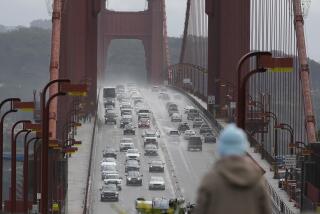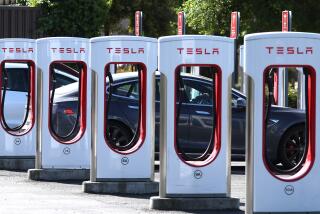EPA May Alter Test of Fuel Economy
Federal regulators Tuesday proposed a new method of estimating fuel economy for cars and trucks starting with 2008 models, heeding calls from consumers and environmentalists who have complained that current mile-per-gallon figures don’t reflect everyday driving.
The new system would mark the first change to the Environmental Protection Agency’s mileage test procedure in 20 years and is likely to cut highway fuel economy estimates for many models by 15% and by 20% for city driving.
Under the new proposal, the EPA would add tests that simulate high-speed driving, rapid acceleration and stop-and-go driving in heavy traffic to a series of lab tests. The new tests also would consider for the first time the effect on fuel efficiency of starting vehicles in cold temperatures and of using air conditioning in warm climates.
The EPA currently relies on a standard series of indoor lab tests that simulate driving in mild weather at top highway speeds of 60 mph and average speeds of 48 mph. Vehicles are mounted on dynamometers -- machines that spin their wheels to calculate mileage. The EPA acknowledges that the tests simulate driving conditions that are less severe than what most drivers encounter.
Congress mandated a testing change in last year’s energy bill.
“The old system is broken,” said Jason Mark, director of the clean vehicles program for the Union of Concerned Scientists. “This is a good first step in fixing it.”
The EPA mileage figures are listed on price stickers of new passenger vehicles.
Carmakers must use the EPA ratings in their advertising because they are the only official measure, but they acknowledge that the government mileage figures are usually inaccurate.
Toyota Motor Corp., maker of the gasoline-electric-powered Prius hybrid, was one of the companies seeking the new tests after becoming concerned that customers felt deceived by the EPA mileage claims for the car.
The federal rating says the Prius averages 60 mpg in the city and 51 mpg on the highway, but many drivers find they average 40 to 45 mpg in everyday use.
Gasoline-electric hybrids would be most affected by the new EPA tests: Ratings for city driving could decrease by 20% to 30% for those vehicles, the agency said.
EPA Administrator Stephen L. Johnson said the agency wanted to give consumers “the most accurate information possible about a vehicle’s fuel economy,” including more details about the effects of “power-hungry accessories” such as electric windows, adjustable seats and even DVD players.
“Mileage varies due to weather, road conditions, obeying the posted speed limits, tire inflation and other vehicle-maintenance conditions,” said Fred Webber, president of the Alliance of Automobile Manufacturers.
The initial call for a change in EPA mileage tests came last year from environmental group Bluewater Network, which petitioned for an overhaul of the system.
Much of the work that led to the new mileage tests was developed by the Automobile Club of Southern California at its Diamond Bar test center. “We did the [field] research last summer,” said Steve Mazor, the Auto Club’s chief engineer and manager of automotive testing.
A group of Auto Club volunteers drove various cars, sport utility vehicles, pickups and hybrid vehicles using the driving techniques included in the proposed new tests. Odometers and speedometers were calibrated by the Auto Club’s engineers to ensure accurate fuel economy figures. Those results showed the new tests were far more accurate in estimating mileage.
“We gave the information to the EPA in September to encourage them to act,” Mazor said.
Despite the lower mileage ratings, Johnson said the EPA test results would not be used to determine whether automakers complied with federal laws requiring their passenger vehicle fleets to have an average fuel economy of 27.5 mpg for cars and 21 mpg for light trucks.
That’s because the Corporate Average Fuel Economy program is run by the Transportation Department and uses different requirements to determine vehicles’ fuel economy, he said.
Times wire services were used in compiling this report.






